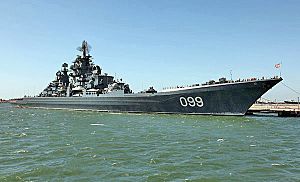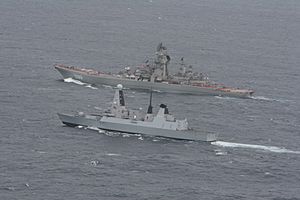Russian battlecruiser Pyotr Velikiy facts for kids
 |
|
Quick facts for kids History |
|
|---|---|
| Name | Pyotr Velikiy |
| Namesake | Peter the Great |
| Builder | Baltic Shipyard, designer Severnoe PKB |
| Laid down | 1986 |
| Launched | 1996 |
| Commissioned | 18 April 1998 |
| Status | in active service |
| Notes | Flagship of the Russian Northern Fleet |
| General characteristics | |
| Class and type | Kirov-class battlecruiser |
| Displacement |
|
| Length |
|
| Beam | 28.5 m (94 ft) |
| Draft | 9.1 m (30 ft) |
| Installed power | 140,000 shp (100,000 kW) |
| Propulsion | 2-shaft, nuclear propulsion with steam turbine boost |
| Speed | 32 knots (59 km/h) |
| Range |
|
| Complement |
|
| Sensors and processing systems |
|
| Armament |
|
| Armour | 76 mm plating around reactor compartment, light splinter protection |
| Aircraft carried | 3 × Kamov Ka-27 "Helix" or Ka-25 "Hormone" helicopters |
| Aviation facilities | Below-deck hangar |
The Pyotr Velikiy (meaning Peter the Great in Russian) is a very large warship in the Russian Navy. It is the fourth ship of its kind, known as a Kirov-class battlecruiser. These ships are sometimes called "battlecruisers" because they are among the biggest surface warships in the world.
This ship was first named Yuri Andropov, after a former leader of the Soviet Union. But its name was changed to Pyotr Velikiy after the Soviet Union ended. The ship is the main ship, or flagship, of Russia's Northern Fleet.
Building the Pyotr Velikiy took a long time because of money problems in Russia. It was started in 1986 but wasn't finished and ready for use until 1998, twelve years later.
Contents
Service History
After its tests in 1996, the Pyotr Velikiy joined the Northern Fleet in Severomorsk. It became the fleet's flagship.
Early Missions and Repairs
In August 2000, the Pyotr Velikiy was part of a big naval exercise in the Barents Sea. During this exercise, a submarine named Kursk had an accident and sank. The Pyotr Velikiy helped guard the area during the rescue efforts in 2001.
In 2004, the ship needed some repairs. It was put into a special floating drydock to fix its steering and paint its hull. These repairs were finished later that year, and the ship was back in action by August.
From September to October 2004, the Pyotr Velikiy went on its first long journey. It sailed with other Russian warships, including the aircraft carrier Admiral Kuznetsov, into the north-western Atlantic Ocean. This was the biggest Russian naval exercise since the end of the Cold War.
Voyages and Exercises (2008–2009)
In September 2008, the Pyotr Velikiy sailed to the Caribbean Sea to train with the Venezuelan Navy. This was the first time Russia had sent such a large group of warships to the Caribbean since the Cold War ended. The ship visited ports in Turkey and France before heading to Venezuela.
In Venezuela, the Pyotr Velikiy took part in a joint exercise called VENRUS-200. After this, it continued its journey alone to Cape Town, South Africa.
In January 2009, the ship joined other Russian warships for a joint exercise with the Indian Navy. This exercise was called INDRA-2009.
While sailing off the coast of Somalia in February 2009, the Pyotr Velikiy captured ten pirates who were in three boats.
The ship returned to its homeport in Severomorsk in March 2009, after a six-month mission.
Later Missions (2010-2016)
In March 2010, the Pyotr Velikiy began another six-month journey. It sailed through the Atlantic Ocean and the Mediterranean Sea, then through the Suez Canal into the Indian Ocean. There, it trained with other Russian warships.
In April 2010, the missile cruiser visited the port of Tartus in Syria. Later, in May 2010, it met up with another Russian cruiser, Moskva, in the South China Sea for joint exercises. The ship returned to its home base in September 2010, having traveled about 28,000 nautical miles.
In September 2013, the Pyotr Velikiy led a group of Russian Navy ships through the Northern Sea Route. This was to prepare for regular patrols in that area.
In 2014, the Pyotr Velikiy sailed through the English Channel with other Russian ships, including the aircraft carrier Admiral Kuznetsov. A British destroyer, HMS Dragon, watched the Russian ships as they passed by.
In May 2016, the Pyotr Velikiy went to sea for drills after two years. In October 2016, it escorted the Admiral Kuznetsov to the Mediterranean Sea. They were heading to the Eastern Mediterranean to support forces in Syria. The Pyotr Velikiy passed through the English Channel again, watched by the British destroyer HMS Dragon.
Recent Activities (2019-2022)
In April 2019, the ship entered the Barents Sea with the cruiser Marshal Ustinov and several submarines for exercises. In October 2019, it went into the Barents Sea again with about 15 other warships for large-scale drills.
In May 2020, the ship went to the Barents Sea for another exercise. In July, Pyotr Velikiy and Marshal Ustinov held an exercise in the Barents Sea, firing missiles.
In May 2021, Pyotr Velikiy went to sea with about 10 other warships. In June, it was still taking part in a 20-ship exercise. It went to sea again in July. In September, the cruiser conducted another missile exercise in the Barents Sea with Marshal Ustinov.
In January 2022, the cruiser performed an air defense drill while still in port. In February, Pyotr Velikiy, along with a frigate and submarines, started an exercise in the Barents Sea. In March 2022, it held an exercise between Norway and Iceland during a large NATO naval exercise. In April 2022, Pyotr Velikiy was at sea again, practicing artillery.
In June 2022, the sailors began preparing for the Navy Day parade. From August 17 to 26, 2022, Pyotr Velikiy was at sea during a large exercise and fired a missile. It was joined by other ships and submarines. In October and November 2022, the ship was also underway in the Barents Sea.
Accident and Incidents
On October 16, 1996, a pilot from the Swedish Air Force was flying a reconnaissance plane near the Pyotr Velikiy in the Baltic Sea. The pilot had an accident and died while trying to avoid another aircraft during the flight.
Gallery
-
Russian president Vladimir Putin visiting Pyotr Velikiy
See also
 In Spanish: Piotr Velikiy (1998) para niños
In Spanish: Piotr Velikiy (1998) para niños






